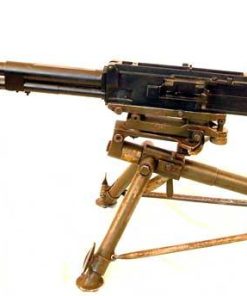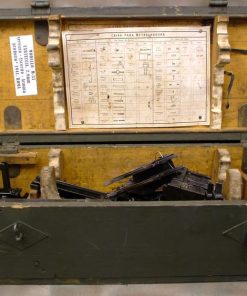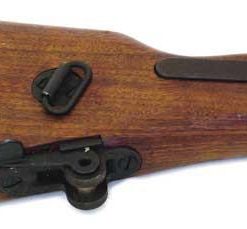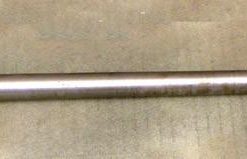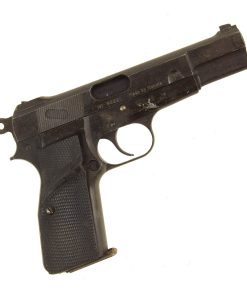Original German WWII Collection of V1 Rocket Manufacture Tool Tags Found at Mittelbau Original Items
$ 395,00 $ 118,50
Original Items. Only One Lot Available. This is a great lot of WWII V1 Rocket tool tags which were dug up at Mittelbau, Germany. There are 15 tags in total, also included are two ammunition casings and a small bit of barbed wire that were dug up along with the tags.
The Kohnstein hill near Nordhausen had been mined since 1917. This mining left a series of tunnels, and these were planned for underground storage petroleum reserves in 1934. In the middle of 1943, this complex was the largest storage area for fuel and oil in all of Germany. But Adolf H’s project of his secret “Revenge Weapons” – the V-1 and V-2 rockets – had a higher priority. A company called the “Mittelwerk” took over the work, and rushed the tunnel system to completion.
Mittelwerk eventually produced V-2 rockets, V-1 “flying bombs,” and jet engines for Me 262 and Ar 234 aircraft. By 11 April 1945, when the U.S. Army 3rd Armored Division overran the complex, the Mittelwerk had produced over 13,000 V-1 and V-2 rockets.
The Americans, and later the British, removed as many completed rockets and parts as they could (this led to the birth of the United States space program), and the Soviets took over the site in July 1945. After taking what they wanted, the Russians attempted to blow up the interior tunnels. Finding this impossible, in 1948 they sealed all the exterior tunnel entrances by explosion. After German reunification in 1989, explorers found that the Soviets had left behind an amazing array of V-1 and V-2 parts. Some parts were recovered for display in museums while a few parts went to collectors. This set of pieces came from those recovered parts.
The tags all have the same triangular VDM logo. Vereinigte Deutsche Metallwerke, or United German Metalworks, was a society of medium-sized firms formed in 1930. The original Vereinigte Deutsche Metallwerke AG (VDM) was founded in 1930 by the takeover of Heddernheimer Kupferwerk and Süddeutsche Kabelwerk AG in Frankfurt by Berg-Heckmann-Selve AG in Altena. The merger took place on the initiative of Metallgesellschaft, which was the main shareholder of Heddernheimer Kupferwerke since 1893 and also took over the majority of the new corporate group. The global economic crisis had forced a consolidation of previously competing companies.
Two of the tags are smaller data plates which would have come off of the side of the rocket parts. This is a really phenomenal set of V1 Rocket tool tags, the first of its kind we have offered. They come ready for further research and display!
The V-1 flying bomb ,—was an early cruise missile and the only production aircraft to use a pulsejet for power. The V-1 was the first of the so-called “Vengeance weapons” series the successful Allied landings in France. At peak, more than one hundred V-1s a day were fired at south-east England, 9,521 in total, decreasing in number as sites were overrun until October 1944, when the last V-1 site in range of Britain was overrun by Allied forces. After this, the Germans directed V-1s at the port of Antwerp and at other targets in Belgium, launching a further 2,448 V-1s. The attacks stopped only a month before the war in Europe ended, when the last launch site in the Low Countries was overrun on 29 March 1945.
As part of operations against the V-1, the British operated an arrangement of air defences, including anti-aircraft guns and fighter aircraft, to intercept the bombs before they reached their targets, while the launch sites and underground storage depots became targets for Allied attacks including strategic bombing.
In 1944, a number of tests of this weapon were conducted in Tornio, Finland. According to multiple soldiers, a small “plane”-like bomb with wings fell off of a German plane. Another V-1 was launched which flew over the Finnish soldiers’ lines. The second bomb suddenly stopped its engine and fell steeply down, exploding and leaving a crater around 20–30 meters wide. The V-1 flying bomb was referred to by Finnish soldiers as a “Flying Torpedo” due to its resemblance to one from afar.
Fast Shipping with Professional Packaging
Thanks to our longstanding association with UPS FedEx DHL, and other major international carriers, we are able to provide a range of shipping options. Our warehouse staff is expertly trained and will wrap your products according to our exact and precise specifications. Prior to shipping, your goods will be thoroughly examined and securely secured. We ship to thousands clients each day across multiple countries. This shows how we're dedicated to be the largest retailer on the internet. Warehouses and distribution centres can be located throughout Europe as well as the USA.
Note: Orders with more than one item will be assigned a processing date depending on the item.
Before shipping before shipping, we'll conduct a thorough inspection of the items you have ordered. Today, the majority of orders will be delivered within 48 hours. The delivery time will be between 3-7 days.
Returns
The stock is dynamic and we cannot completely manage it because multiple stakeholders are involved, including our factory and warehouse. So the actual stock may alter at any time. It's possible that you may not receive your order once the order has been made.
Our policy is valid for a period of 30 days. If you don't receive the product within 30 days, we are not able to issue a refund or an exchange.
You can only return an item if it is unused and in the same state as the day you received it. You must have the item in its original packaging.
Related products
Uncategorized
Uncategorized
Uncategorized
Uncategorized
Uncategorized
Band of Brothers ORIGINAL GERMAN WWII Le. F.H. 18 10.5cm ARTILLERY PIECE Original Items
Uncategorized
Uncategorized
Uncategorized
Uncategorized
Uncategorized
Uncategorized
Angolan Rebel 1970s era 60mm Inert Display Mortar from Angolan Civil War Original Items
Uncategorized
Uncategorized
Uncategorized


















